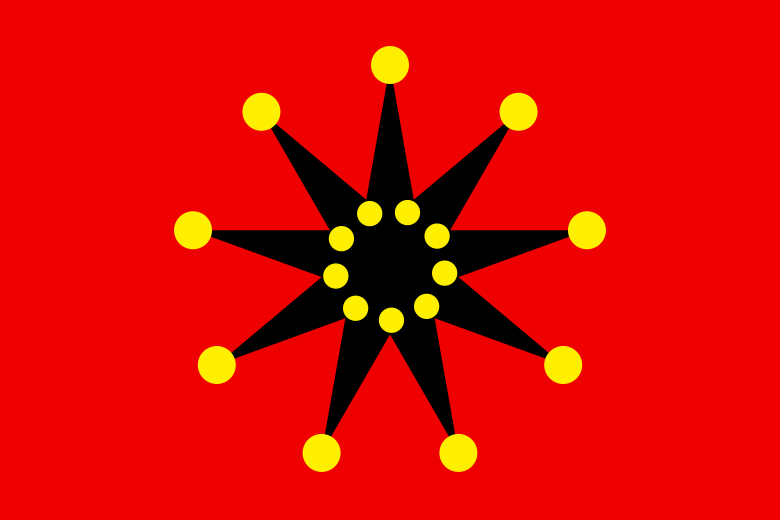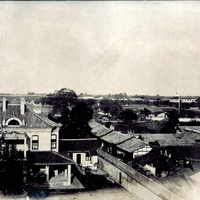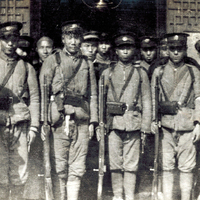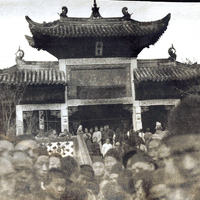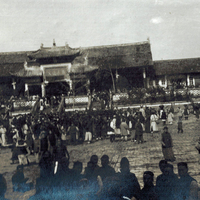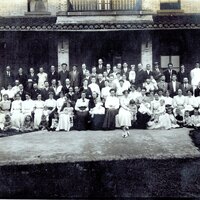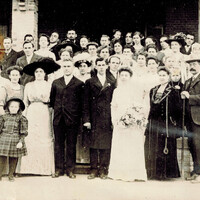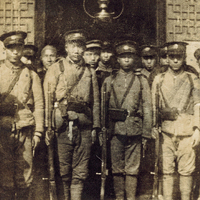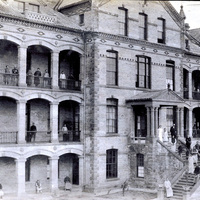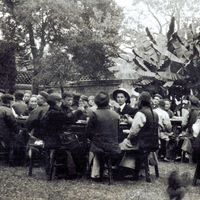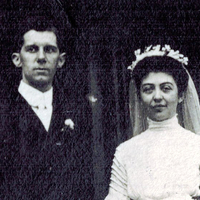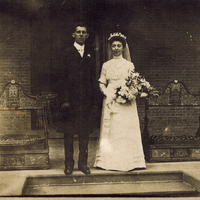-
Title
-
1911 Revolution in Chengdu
-
Description
-
This event begins with news that the Chengdu Yamen has ordered all missionaries to move inside the city walls. It continues with the Johns' confinement in the Canadian Methodist Mission's new hospital (Sept. 6th - Nov. 17th, 1911) to the various activities around Chengdu on November 25th, 1911, which include the induction of new leadership and Walter and Lottie Small's wedding.
-
Commentary
-
In standard histories of the Chinese Nationalist Revolution, also known as the Xinhai Revolution, the starting point was the Wuchang Uprising of October 10th, 1911. However, in Chengdu, hostilities broke out earlier on September 1st when Sichuanese leaders signed a petition to withhold taxes from the imperial government. These officials and a powerful lobby group called the T'ong Chi Hwei, or Railway League, were in conflict with the central government over who was to build the Hankow-Chengdu railway, foreigners or Chinese. When the government gave the contract to foreigners, riots broke out in Sichuan (5)(3). This case was never settled, and ultimately the Hankow-Chengdu railway had to wait until after the Communist takeover in 1949. John Service, who edited Grace Service’s extensive account of these events, notes that it is unlikely that the Sichuanese leaders really had revolution in mind when they signed the petition. However, they whole-heartedly embraced the cause after the Wuchang Uprising and the success of the revolution mounted (4).
The experience of the revolution began for missionaries in Chengdu very dramatically on Sept. 6th when the British Consul in Chengdu ordered all English-speaking missionaries to confine themselves in the new Canadian hospital, whose construction was not yet finished. Work on the hospital had begun in 1907 under Dr. Ewan’s direction. When Ewan was forced to return to Canada due to ill health in the summer of 1911, Dr. Service was put in charge of medical work in Chengdu, and Walter Small was assigned to the building of the hospital. However, Small had barely begun his new assignment when the hospital was converted into a temporary encampment for the missionaries. Walter Small himself was stricken with typhoid fever while confined in the hospital he was to build (1).
According to Grace Service, there were 225 missionaries camping out at the hospital (4), while May Carscallen estimated 140 (3). George E. Hartwell gives the conservative estimate at 124 (2), while Lily Hockin reported 105, although she was not personally there because she was stationed in Leshan at the time (1). Part of the variance in numbers derives from the fact that some missionaries were staying at other locations within the large Canadian Methodist Mission compound on Sichengci Street, Chengdu. Another factor is that these missionaries were completely cut off from all communications with the outside world – no postal service, wires or newspapers (4). They also had no contact with other foreigners in Chengdu (1).
These missionaries’ isolation can be illustrated by the crisis caused by several of them being caught outside the compound when the Sichuan Governor arrested the leaders of the Railway League on Sept. 7th and closed the city gates on Sept. 8th. These were Charlie Carscallen of the Canadian Methodist Mission, as well as Dr. Joseph and Mrs. Helena Taylor and Elrick Williams of the American Methodist Episcopal Mission (4). The Governor could not assure protection for any foreigners outside the city gates, and also refused to help them get back in. Acting against the Consul’s advice, Bob Service (of the YMCA) and several others concocted a scheme to bring them into the city by a rope over the city wall. First, they lowered two Chinese servants over the wall with a note for the stranded missionaries, who were found having dinner in one of their homes at the West China Union University. Then, under cover of night in the worst rain storm of the year, the four missionaries and two Chinese men made their way from the campus to the city where they were dragged up over the 50 foot wall to rejoin their families after 36 hours of uncertainty (1)(3)(4).
Grace Service gives insightful details of the missionaries’ lifestyle within the half-built hospital:
“The outlook at the Canadian hospital was anything but cheerful. The building was not entirely completed; it was still surrounded by debris from the construction. The rooms were dusty, few windows were glazed, there were no stair railings, most doors were hung but lacked knobs and latches. Scores of foreigners were milling about, trying to decide what to do. It was noisy and disturbing. No naps for children were possible, so the plaints of many weary youngsters were added to the clamor echoing through the empty halls” (4).
Soon the missionaries organized church services and committees to oversee security and supplies, as well as entertainment including bridge and tennis matches (1)(3)(4). Rumors of fighting and looting came in regularly, but there was no way of knowing what was really going on. The security guards would climb out onto the roof to watch for bombings and other violence. As Grace Service reported:
“Life and death visited our little concentration camp. There were three births; one child died; several people had severe illnesses; and one or two engagements came about. Some left the hospital with warmer feelings toward hitherto casual acquaintances; a few had broken friendships to sadden memories of our days together” (4).
After ten weeks in confinement, on November 17th, the missionaries were told they could leave the hospital. The adventure was not over, however.
Soon after moving back to their own homes in Chengdu and on the West China Union University campus, Walter Small and Lottie Lawson made arrangements for their wedding. Taking no chances that no further political developments could come between them, they scheduled the wedding for November 25th, 1911, in Chengdu. Their romance had been percolating for several years, but it flourished while Lottie nursed Walter through typhoid fever in the hospital. Walter had been appointed to the Canadian Methodist Mission with the anticipation that he would be married upon leaving for China. However, his engagement fell through and he found himself going to China single (6). Acutely aware of the problem of female missionaries trained by the Women’s Missionary Society defecting to marry male missionaries, Lottie had held out from marriage to put in service to the WMS. But now was the time.
The Small’s couldn’t have been more prescient. The same day as their wedding, a proclamation was posted on city walls and news spread around that Chengdu had fallen to the revolutionaries. Swarms of soldiers, mercenaries and bandits looted the banks and shops of Chengdu (7). Two days later the president of the Railway League, Pu Tien-chun, was sworn in as Governor of Sichuan (1)(4). However, when he was unable to control the marauding bands, the position of foreigners was uncertain at best. Finally, it appeared dire after the former Imperial Governor of Sichuan, Chao Erh-feng, had been executed (7).
Not long after, on December 2nd, 1911, a large party of 31 Canadians departed Chengdu for the coast. The Johns were likely among them. Four days later, a party of American Methodists also evacuated. By December 7th, it was clear that all missionaries must go and even the most steadfast men began making arrangements to leave (4). On December 9th, the top two leadership positions in the new Sichuan government were taken by Grand Masters of the Gown Brotherhood, and chapters of that society took over local affairs. As Consul-General G. A. Combe observed over a decade later, “It was the beginning of the government of Szechuan by the Szechuanese for the Szechuanese” (7). For the continuation of the evacuated missionaries’ story, see the Nationalist Revolution Evacuation, 1911-1912 Event record.
-
Event Date
-
1911-09-02 to 1911-11-25
-
References
-
(1) Donnelly, Mary Rose, and Heather Dau. 1992. Katherine Boehner Hockin: A Biography. Winfield, BC: Wood Lake Books.
-
(2) Hartwell, George E. 1939. Granary of Heaven. Toronto: United Church of Canada.
-
(3) Lapp, Eula C. 1980. China Was My University: The Life of Hulda May Carscallen. Agincourt, ON: Generation Press.
-
(4) Service, Grace 1989. Golden Inches: The China Memoir of Grace Service. John S. Service, ed. Berkeley: University of California Press.
-
https://publishing.cdlib.org/ucpressebooks/view?docId=ft3k4005b9;brand=ucpress
-
(5) Service, John. 1977-1978. China Series: John S. and Caroline Service Oral History Project, Volume I. Interview by Rosemary Levenson, Regional Oral History Office, The Bancroft Library, University of California Berkeley, California.
-
https://www.loc.gov/item/mfdipbib001045/
-
(6) UCCA West China Mission Collection, 1891-1931, 1978.096C Box 9, file 72.
-
(7) Combe, G. A. 1924. Events In Chengtu, 1911: Extracts from an Address to the Fortnightly Club, Chengtu, March 25th, 1924. West China Missionary News 26(5): 5-18.
-
Type
-
Event
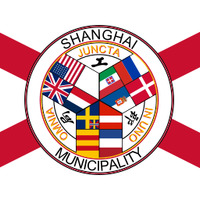 1911-1912 Nationalist Revolution Evacuation
1911-1912 Nationalist Revolution Evacuation
